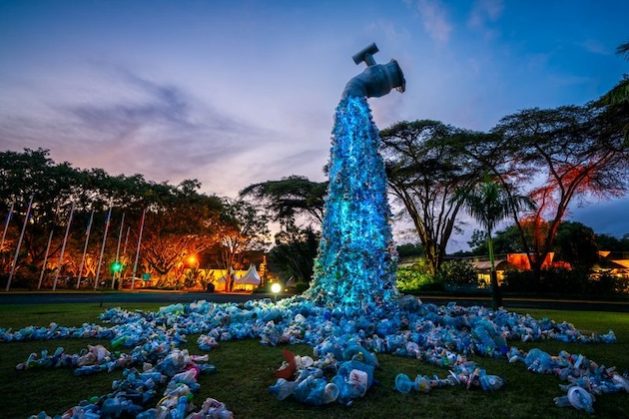NEW DELHI, Mar 28 (IPS) – “The size of the faucet highlights the magnitude of the problem. It makes the problem impossible to ignore. We’re used to throwing things ‘away’—but when we’re confronted with what happens when ‘away’ is not an option, I think it creates an emotional wake-up call,” says Benjamin Von Wong.
The 39-year-old Canadian artist and activist is referring to his inspiration behind The Giant Plastic Tap installation, which created a buzz in the art world, highlighting the problem of plastic pollution.
Wong, known for his environmental art installations and hyper-realist art style, created the Giant Plastic Tap that features an oversized faucet seemingly floating in mid-air while spewing plastic waste, serving as a striking metaphor for the world’s urgent need to address plastic production at its source.
He explains, “I wanted to bring the phrase ‘Turn off the plastic tap’ to life in a tangible way. I adapted the concept of the ‘floating fountain’ but distorted it with plastic—to emphasize the urgency of tackling the problem at its source by reducing plastic production, rather than relying solely on downstream solutions like recycling and beach cleanups.”
Reportedly, the global effects of plastic pollution are becoming more evident, highlighting the urgent need for collective action. Scientific studies and policy changes are essential but it is also crucial to acknowledge the influence of art in raising awareness and inspiring people to act.
Art has a unique power to evoke emotions, ignite conversations, and build a deep connection between individuals and the environment.
In the fight against plastic pollution, one art installation has become a powerful symbol of change, with Wong playing an important role.
Plastic pollution is one of the biggest crises of this generation.
The latest study, by charity EA Earth Action and released last year, revealed that more than a third of plastic waste will be improperly handled at the end of its lifecycle. This equates to 68.6 million tonnes of plastic, translating to an average of 28kg of plastic waste per person worldwide. In 2024, approximately 220 million tonnes of plastic waste were generated, marking a 7.11 percent increase since 2021.

Art installed so far
Von Wong, who shifted from mining engineering to environmental activism through art, has created four large-scale faucet installations, showcased at venues including Art Basel, the United Nations Environment Assembly 5.2 in Nairobi (2022), and the United Nations Ocean Conference.
“We’ve installed them in over a dozen locations—but even more exciting is that hundreds of cardboard replicas have been made worldwide,” Wong says.
Wong reflects, “I’m not sure how you measure the impact of art, but I think the fact that this installation has become a symbol for the importance of a global plastic treaty is probably the biggest achievement.”
The Giant Plastic Tap has been featured at previous INC (Intergovernmental Negotiating Committee for the plastic treaty) sessions. However, its absence was notably felt during the INC-5 conference in Busan, South Korea.
Wong says, “I did my best to have the tap installation placed in Busan, but it wasn’t allowed. Instead, the ‘beached whale’ was placed on the lawns of BEXCO, the exhibition center that hosted the event last year.” He adds, “Despite reaching out over six months in advance to the operations team, the delegation, and securing local partners with independent funding, we were met with silence.”
Interestingly, INC-5 failed to reach a consensus on the global plastic treaty due to disagreements over national interests, industry influence, financial and technical support, and enforcement mechanisms.
Despite current challenges in global plastic treaty negotiations, including the presence of fossil fuel lobbyists and the constraints of consensus-based decision-making, Artist Wong remains optimistic about the future. “I’m certain we will find a way forward,” he asserts, pointing to the numerous dedicated individuals and organizations working to advance the treaty.
Meanwhile after the Intergovernmental Negotiating Committee decided to postpone the fifth session, the Executive Director of the United Nations Environment Programme (UNEP) is consulting to determine the new date and venue for the resumed session (INC-5.2)
Involving locals
Wong involved the local communities to complete the installation at UNEA 5.2 in Nairobi. The project collaborated with the Human Needs Project to collect three tons of plastic from the Kibera slums. The initiative employed over 80 local women to clean and organize the plastic, ensuring their voices were heard by world leaders. “We also fundraised to support the creation of a more local waste management system,” he adds.
The installation has achieved significant success in its mission to influence public perception. Viewers consistently grasp the fundamental message about the need to stop plastic pollution, and the installation’s visual impact helps transform an intellectual discussion into an emotional experience. Its symbolism has become particularly significant in the context of the global plastic treaty discussions.
Lastly, can art play a pivotal role in driving real-world change? To this Wong draws a compelling parallel: “What is the value of a monument like the Statue of Liberty? How would you measure it?”




